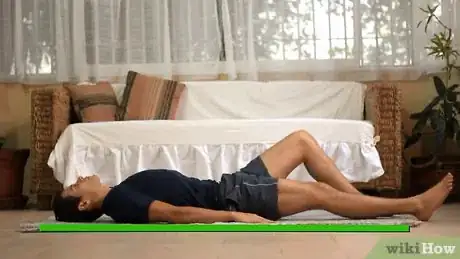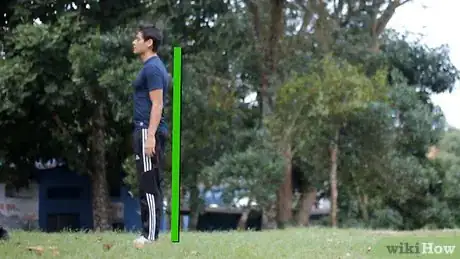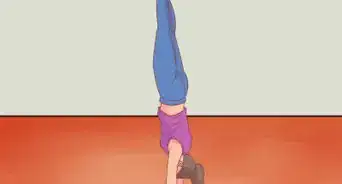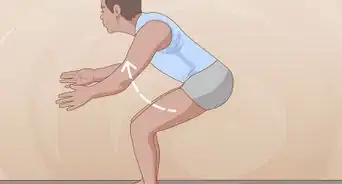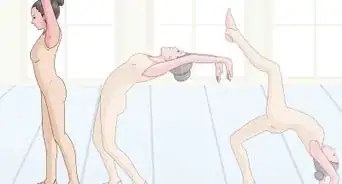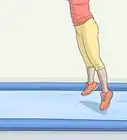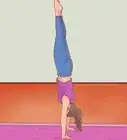This article was co-authored by Rosalind Lutsky, a trusted member of wikiHow's volunteer community. Rosalind Lutsky worked as a gymnastics coach at SB Gymnastics at Stanford University, coaching children from ages 5-12 years old during her time as a Stanford student. She was a competitive gymnast growing up, and competed for her local gymnastics team in Minnesota.
There are 9 references cited in this article, which can be found at the bottom of the page.
wikiHow marks an article as reader-approved once it receives enough positive feedback. In this case, several readers have written to tell us that this article was helpful to them, earning it our reader-approved status.
This article has been viewed 465,740 times.
Learn more...
A bridge is a type of move that’s often seen in gymnastics, yoga, and Pilates. There are several different versions of the bridge and different variations for beginners and experts. The move is a good way to work out a number of muscles, including the gluteus maximus, hamstrings, and quadriceps, and it’s also good for stretching the spine and hips. It’s always advisable to stretch before doing any sort of exercise, and if you haven't done a bridge before, start with the beginner bridge pose and work your way up to the full bridge and the backbend.
Steps
Executing a Yoga Bridge Pose
-
1Lie on your back. Bridge pose, or short bridge, is a beginner backbend exercise that’s common in yoga and Pilates. It’s not nearly as strenuous as the full gymnastics bridge. It is performed on the ground, and the shoulders never leave the floor, so it’s a good move for beginners.[1]
- Bridge pose is good for stretching the spine, neck, thighs, and hip flexors.
- This exercise will work best if you're on a cushioned but firm surface, such as a carpeted area or an exercise mat on the floor.
-
2Bend your knees. While on your back, bend your knees to bring your feet in toward your bum. Make sure you keep the soles of your feet flat on the ground and your knees shoulder-width apart.[2]Advertisement
-
3Extend your arms out beside your body. Keep your palms flat on the ground. If your fingers can't touch your heels, bring your feet in closer.
-
4Lift off the ground. In bridge pose, your feet, shoulders, arms, and hands stay on the ground. Push into the ground equally with these parts to lift the rest of your body off the ground. You want your legs, hips, buttocks, and back to come off the ground and raise toward the ceiling.
-
5Lift your chest. This will help stretch out your back fully.[3] At this point, your knees should be bent and your weight evenly distributed between your feet, shoulders, and upper arm area.
- Your neck should be able to move freely, but do not turn your head in bridge pose).[4]
- Keep your feet parallel and flat on the ground, and keep your thighs aligned and slightly apart.
- Hold bridge pose in this way for at least one minute, or go on to one of the variations.
-
6Bring your hands together under your body. This is one minor variation of bridge pose. Because your weight is on your shoulders and upper arms, you should be able to bring your palms together under your body and clasp your hands together.[5]
- Keep your arms extended and pressed into the mat as you do this. Make sure your palms are touching.
-
7Try the single-leg variation. Another version of bridge pose involves lifting one knee at a time while maintaining the pose. With your arms flat on the ground or together under your body, lift one foot off the ground and bring your knee in toward your chest.
- Hold this for 30 seconds before putting your foot back on the ground and repeating with the other leg.
- Don’t let your hips or buttocks drop toward the ground when you're on one foot.[6]
-
8Release from bridge pose. Unclasp your hands and place your arms beside your body again, palms flat on the ground. Slowly, and with control, lower your chest and back, starting at the neck and working your way down your spine until your bottom is on the ground again.[7]
Pushing up Into a Gymnastics Bridge
-
1Lie on your back. A more advanced version of the bridge, which is common in gymnastics, is to push your body up into a full bridge, which is sometimes called the full wheel.
-
2Bend your knees. Bring your feet in so they're touching your bum. Keep your feet flat on the ground.
-
3Position your hands. Bend your elbows and bring your hands up beside your ears. Place your palms flat on the ground with your fingers facing your toes.[8]
-
4Push yourself up into the bridge. To achieve this, you need to push with your legs to get your legs, hips, back, and chest off the ground. At the same time, use your arms to push your head, neck, and shoulders off the ground as well.
- If you have trouble pushing into bridge, try tucking your feet in closer to your body and placing your feet farther apart.
EXPERT TIPHave someone spot you if you don't feel comfortable with your bridge, or if your arms just aren't strong enough yet.
Rosalind Lutsky worked as a gymnastics coach at SB Gymnastics at Stanford University, coaching children from ages 5-12 years old during her time as a Stanford student. She was a competitive gymnast growing up, and competed for her local gymnastics team in Minnesota.
Rosalind Lutsky
Former Gymnastics Coach Rosalind Lutsky
Rosalind Lutsky
Former Gymnastics Coach -
5Position your body. As your body comes off the ground, round your back so that your body forms a semi-circle. Straighten your elbows without locking them, and keep your knees slightly bent.
- When in bridge, your head should be tucked in between your upper arms. Try to focus your gaze on a spot on the ground in between your hands.[9]
-
6Come out of bridge. Before you let your body relax, tuck your chin into your chest to protect your spine and neck as you come down.[10] Then, bend your elbows and slowly lower your body to the ground, keeping the weight evenly distributed between your feet and hands.
- As you lower yourself down, place your bottom on the ground first before letting everything else come down.
Getting into Bridge With a Backbend
-
1Stand up straight. The backbend into bridge is the most advanced version of the bridge. To execute this move, you start in a standing position and slowly bend backward until your hands come to the ground and you're in bridge position.
- To begin, stand up with your feet planted firmly on the ground, shoulder-width apart.[11]
- As you become better at backbends, you can bring your feet in closer together when you perform this exercise.
-
2Reach your arms to the ceiling. As you lean backward, you will rely on your arms to eventually catch the ground and support your bridge, so you need your arms fully extended as you lean back.
-
3Round your back and bend backward. Slowly, and with control, round your back as you lean backward, moving your arms and head at the same pace. As you lean, make sure your gaze follows where you're going, so that you can see better and don’t get dizzy.
- If you have trouble executing this or are nervous, practice in front of a wall, so that when you start leaning back, you can catch the wall with your hands and slowly walk your way down to the ground.[12]
-
4Place your hands on the ground. Whether you walked down a wall or executed a full backbend, place your hands on the ground as soon as you can reach.
- Don’t let your chest or back collapse: stay in the rounded back position to hold bridge pose.
-
5Come out of bridge pose. You can come down from bridge pose as usual by lowering yourself down slowly. Or, for people with more flexibility, you can also exit bridge pose by walking back up the wall with your hands or pulling yourself out of the pose the same way you got into it.
-
6Exit bridge pose with a backbend kickover as an alternative. The other way to exit bridge is by kicking your body back into a forward facing position.[13] To do this:
- Bend your knees more and bring your feet in closer to your body. Push your head farther through your arms so that you're looking at your feet.
- Stand on your toes and transfer your weigh to your non-dominant foot. Raise your dominant foot off the ground to about knee-height.
- With your non-dominant foot, push off the ground as you kick your dominant foot up and over your head, followed by your other foot. Place your dominant foot on the ground when it reaches and then your other foot as it comes around, and from there you can stand up.
EXPERT TIPRosalind Lutsky worked as a gymnastics coach at SB Gymnastics at Stanford University, coaching children from ages 5-12 years old during her time as a Stanford student. She was a competitive gymnast growing up, and competed for her local gymnastics team in Minnesota.Former Gymnastics Coach
 Rosalind Lutsky
Rosalind Lutsky
Former Gymnastics CoachRosalind Lutsky, former gymnastics coach, notes: “A backbend kick-over is similar to a backwalkover, which you can do by putting one foot in front of the other when you bend backwards, and kicking over as you go in a fluid motion.”
Community Q&A
-
QuestionWhat if my arms aren't strong enough to lift me up?
 Community AnswerGet your friend or gym coach and lay on your back. Then, get your friend to push you up. The more you practice, the better you will get. You can also do strengthening exercises to improve.
Community AnswerGet your friend or gym coach and lay on your back. Then, get your friend to push you up. The more you practice, the better you will get. You can also do strengthening exercises to improve. -
QuestionHow can I do the bridge while standing?
 Community AnswerThat's called doing a backbend; you can use a wall to help you practise but it is best to ask your gym coach or a friend to help. See further: How to Do a Backbend.
Community AnswerThat's called doing a backbend; you can use a wall to help you practise but it is best to ask your gym coach or a friend to help. See further: How to Do a Backbend. -
QuestionIf I don't have an exercise mat, can I do it on my bed instead?
 Community AnswerTry doing it on the carpet or grass instead. Beds are very squishy, so you won't get the right support. You are more likely to fall while doing a bridge on your bed than on solid ground.
Community AnswerTry doing it on the carpet or grass instead. Beds are very squishy, so you won't get the right support. You are more likely to fall while doing a bridge on your bed than on solid ground.
References
- ↑ https://www.yogaoutlet.com/guides/how-to-do-bridge-pose-in-yoga
- ↑ https://www.youtube.com/watch?v=6HYNo1YQsUk
- ↑ http://yogabycandace.com/blog/common-mistakes-in-bridge-pose
- ↑ https://www.yogaoutlet.com/guides/how-to-do-bridge-pose-in-yoga
- ↑ http://www.everydayhealth.com/columns/everyday-fitness/bridge-pose/
- ↑ http://www.dummies.com/how-to/content/how-to-do-the-pilates-bridge-exercise.html
- ↑ https://www.yogaoutlet.com/guides/how-to-do-bridge-pose-in-yoga
- ↑ https://www.youtube.com/watch?v=S_BBxVlDDz4
- ↑ http://www.refinery29.com/how-to-do-bridge-increase-flexibility
About This Article
To do a bridge pose, lie flat on your back and bend your knees up. Push your hips off the ground and lift your chest, keeping your head relaxed on the ground and arms at your sides. Slowly lower your hips down to release. To do a gymnastics bridge, lie on your back with your knees bent and your hands by your ears, with your palms flat on the ground. Lift your whole body by pushing with your legs and arms. Shift your feet farther apart and closer to your body if you’re having trouble. To lower down, tuck your chin into your chest and bend your elbows. If you want more tips from our Gymnastics Coach co-author, like how to start your bridge by doing a backbend, keep reading the article!
